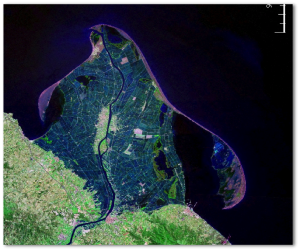HPCCprojects:Coupling fluvial discharge and coastal evolution models
Coupling fluvial discharge and coastal evolution models
Project description
| Modis satellite image of the Ebro Delta |
Deltas are critical landforms at the land-sea interface that preserve the effects of both terrestrial and marine processes. In regions that have been affected by human civilization, deltas can serve as a record of the land-use changes across large watersheds. The Ebro Delta, Spain, with its distinctive plan-view shape, has seen significant changes in the last two millennia, changes that could be related to anthropogenic activities. Combining field research, fluvial modeling, and coastal evolution modeling, this proposed research will address the hypothesis that humans have helped shape the Ebro Delta by investigating what aspects of the delta’s morphology and depositional history can be attributed to external (allogenic) forcing, such as human activities or climate change, and what aspects resulted from background natural variability and autogenic mechanisms such as avulsion and reworking by waves.
Although there have been many studies of the terrestrial input of sediment to the coast, the reworking of sediment by marine processes, and the resultant stratigraphic deposits, this proposed research will uniquely combine all three of these components controlling delta evolution. Although cartographic material suggests a rapid development of the Ebro Delta during post-Roman times, sparse data and limitations on the accuracy of historic maps hinder chronologic interpretation; we propose field investigations to refine the Ebro Delta age model. The climate-driven hydrological model HydroTrend will be used to compute fluvial sediment discharge to the coast, and a modified version of an existing shoreline evolution model will be used to evolve the morphology of the subaerial delta. A key component will be the direct linking of these models as part of the Community Surface Dynamics Modeling System (CSDMS). Model simulations will be constrained by and compared to the field data.
Objectives
- Are humans responsible for the formation of the modern Ebro Delta?
- What is the timing (and style) of the Ebro Delta’s evolution?
- Have humans exerted a first-order control on the fluvial delivery of sediment by the Ebro River to the coast?
- Does wave angle climate act as a first-order control on the morphology and progradation rates of the Ebro (and other wave-influenced deltas)?
Time-line
| Start date: | 01/01/2009 |
| End date: | 12/31/2013 |
Models in use
The following models are two-way coupled and applied in this project:
| HydroTrend | Climate driven hydrological transport model |
| CEM | Coastline Evolution Model |
| Avulsion | Model stream avulsion as random walk |
Results
- Ashton, A.D., Hutton, E.W.H., Kettner, A.J., Xing, F., Kallumadikal, J., Neinhuis, J., and Giosan, L., 2013. Progress in Coupling Coastline and Fluvial Dynamics. Computers and Geosciences, 10.1016/j.cageo.2012.04.004.
- Restrepo, J.D., and Kettner, A.J., 2012. Human induced discharge diversion in a tropical delta and its environmental implications: the Patía River, Colombia. Journal of Hydrology, 424-425, 124-142, 10.1016/j.jhydrol.2011.12.037.
Users
Funding
NSF, award nr.: 0952146
Publications and presentations
Conferences
- Ashton, A., Hutton, E.W.H., Kettner, A.J., Jerolmack, D., and Giosan, L. October 2010. Coupling between coastline and fluvial dynamics. CSDMS conference, Modeling for Environmental change, San Antonio, Texas.
- Kettner, A.J., Xing, F., Ashton, A.D., December 2010. Are Human influences responsible for the existence and possible drowning of (parts of) the Ebro Delta, Spain? AGU fall meeting, San Francisco, USA.
Links
Links that are related to your project. E.g. which models are used (link to model questionnaire or project website if any

